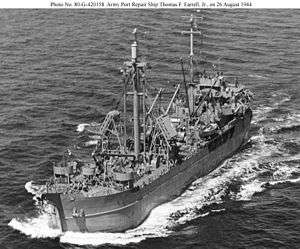Media (AK-83)
Media (AK-83)[Note 1] was a World War II US navy ship that was never commissioned and thus never bore the USS designation.[1]
 Sister ship USAPRS Thomas F. Farrel, Jr. underway off the East Coast of the United States, 26 August 1944. US National Archives photo # 80-G-420158 RG-80-G, a US Navy photo now in the collections of the US National Archives. | |
| History | |
|---|---|
| Ordered: | N3-M-A1 hull, MC hull 468 |
| Laid down: |
|
| Launched: | 29 August 1943 |
| Commissioned: | Never commissioned |
| Stricken: |
|
| Fate: |
|
| General characteristics | |
| Displacement: | 1,677 t.(lt), 5,202 t.(fl) |
| Length: | 269 ft 10 in (82.25 m) |
| Beam: | 42 ft 6 in (12.95 m) |
| Draught: | 20 ft 9 in (6.32 m) |
| Propulsion: | Diesel, single shaft, 1,300shp |
| Speed: | 10 kts. |
| Notes: | The ship was Navy only during construction, transferred to Army upon delivery to Navy and underwent extensive modifications for operation by the Corps of Engineers as a port repair ship. |
Media (AK-83) was contracted to be built as Oliver R. Mumford under Maritime Commission contract 4 September 1941 as a type N3-M-A1 cargo ship. She was acquired by the Navy 1 January 1943 before being laid down by Penn Jersey Shipbuilding Corp., Camden, New Jersey, 28 January 1943; launched 29 August 1943; sponsored by Mrs. Ernest G. Bornheimer; completed and delivered to Navy on 17 November 1943.
That same day Media was delivered to the U.S. Army and struck from the Navy list on 24 November 1943. The ship was renamed Glenn Gerald Griswold after an engineering officer killed while fighting a dump fire in Naples, Italy.[2] The Glenn Gerald Griswold was converted into a port repair ship by Bethlehem Fairfield Shipyard, Inc., Baltimore, Maryland, on 5 June 1944[3] and sailed for Europe by summer's end.[4] After the postwar work the ship was placed in the reserve fleet.
Notes
- Only USS Enceladus (AK-80) of the ten ships of the Enceladus class, composed of Maritime Commission N3-M-A1 type small cargo vessels, saw significant naval service. Of the other nine, excpting USS Hydra (AK-82), all were transferred within months or days of shipyard delivery to Navy to the Army. Hydra was transferred to Army shortly after commissioning and trials. Navy had assumed the administration of contracts for these ships from the Maritime Commission on 1 January 1943 during or before construction and thus most were only administratively Navy, including names and numbers, during construction.
References
- "Archived copy". Archived from the original on 2015-01-03. Retrieved 2009-03-12.CS1 maint: archived copy as title (link) | Navy History & Heritage Command - Ship Naming in the United States Navy
- "Archived copy". Archived from the original on 2008-05-13. Retrieved 2010-01-03.CS1 maint: archived copy as title (link) | County of Los Angeles Fire Museum Association; People Who Made a Difference: Glenn G. Griswold
- "Archived copy" (PDF). Archived from the original (PDF) on 2009-07-23. Retrieved 2010-01-03.CS1 maint: archived copy as title (link) United States Army in World War II - The Corps of Engineers: Troops and Equipment - Chapter XVII - Preparing to Reconstruct Ports
- Grover, David (1987). U.S. Army Ships and Watercraft of World War II. Naval Institute Press. pp. 133–137. ISBN 0-87021-766-6.
This article incorporates text from the public domain Dictionary of American Naval Fighting Ships.
External links